TOYOTA HILUX 2012 Owners Manual (in English)
Manufacturer: TOYOTA, Model Year: 2012, Model line: HILUX, Model: TOYOTA HILUX 2012Pages: 636, PDF Size: 34.38 MB
Page 141 of 636
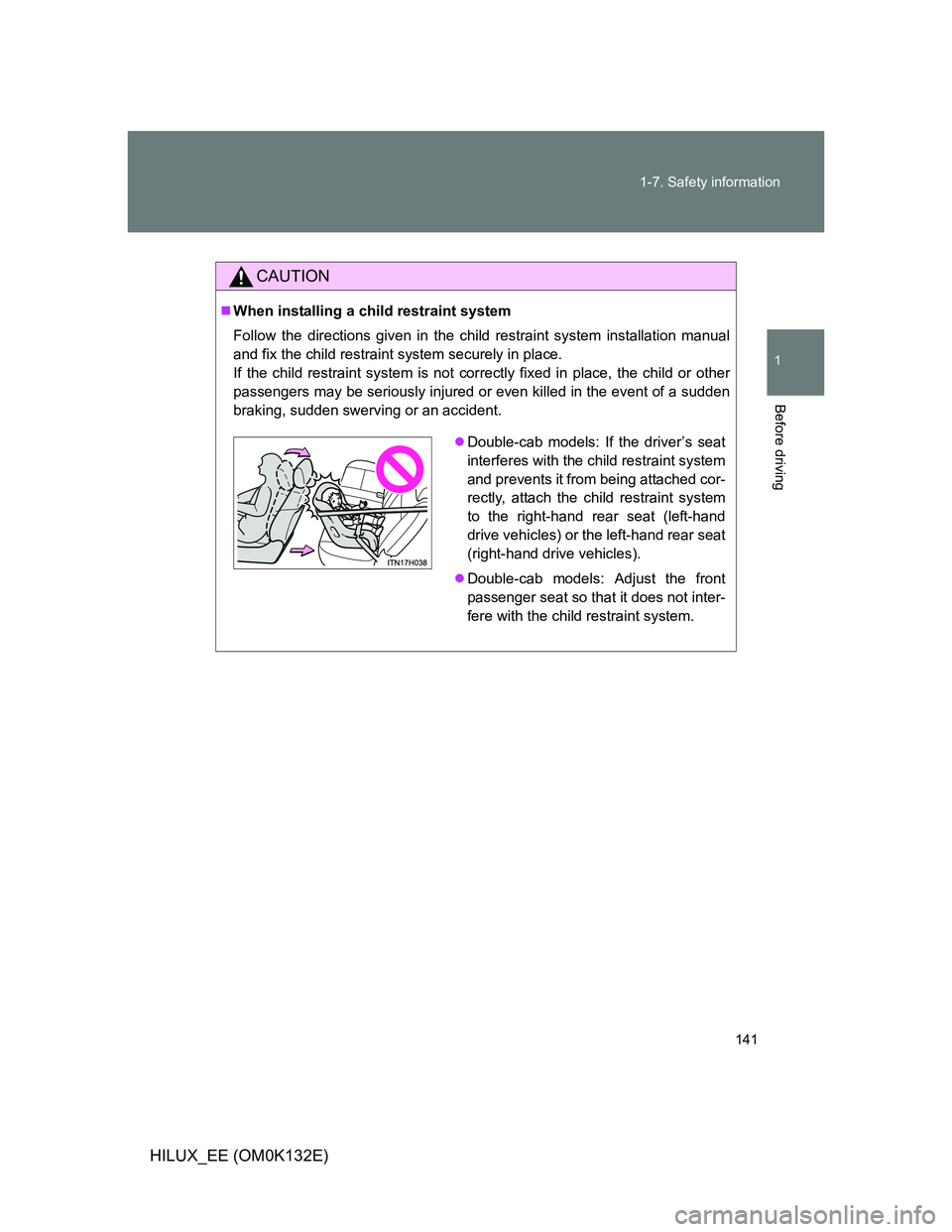
141 1-7. Safety information
1
Before driving
HILUX_EE (OM0K132E)
CAUTION
When installing a child restraint system
Follow the directions given in the child restraint system installation manual
and fix the child restraint system securely in place.
If the child restraint system is not correctly fixed in place, the child or other
passengers may be seriously injured or even killed in the event of a sudden
braking, sudden swerving or an accident.
Double-cab models: If the driver’s seat
interferes with the child restraint system
and prevents it from being attached cor-
rectly, attach the child restraint system
to the right-hand rear seat (left-hand
drive vehicles) or the left-hand rear seat
(right-hand drive vehicles).
Double-cab models: Adjust the front
passenger seat so that it does not inter-
fere with the child restraint system.
Page 142 of 636
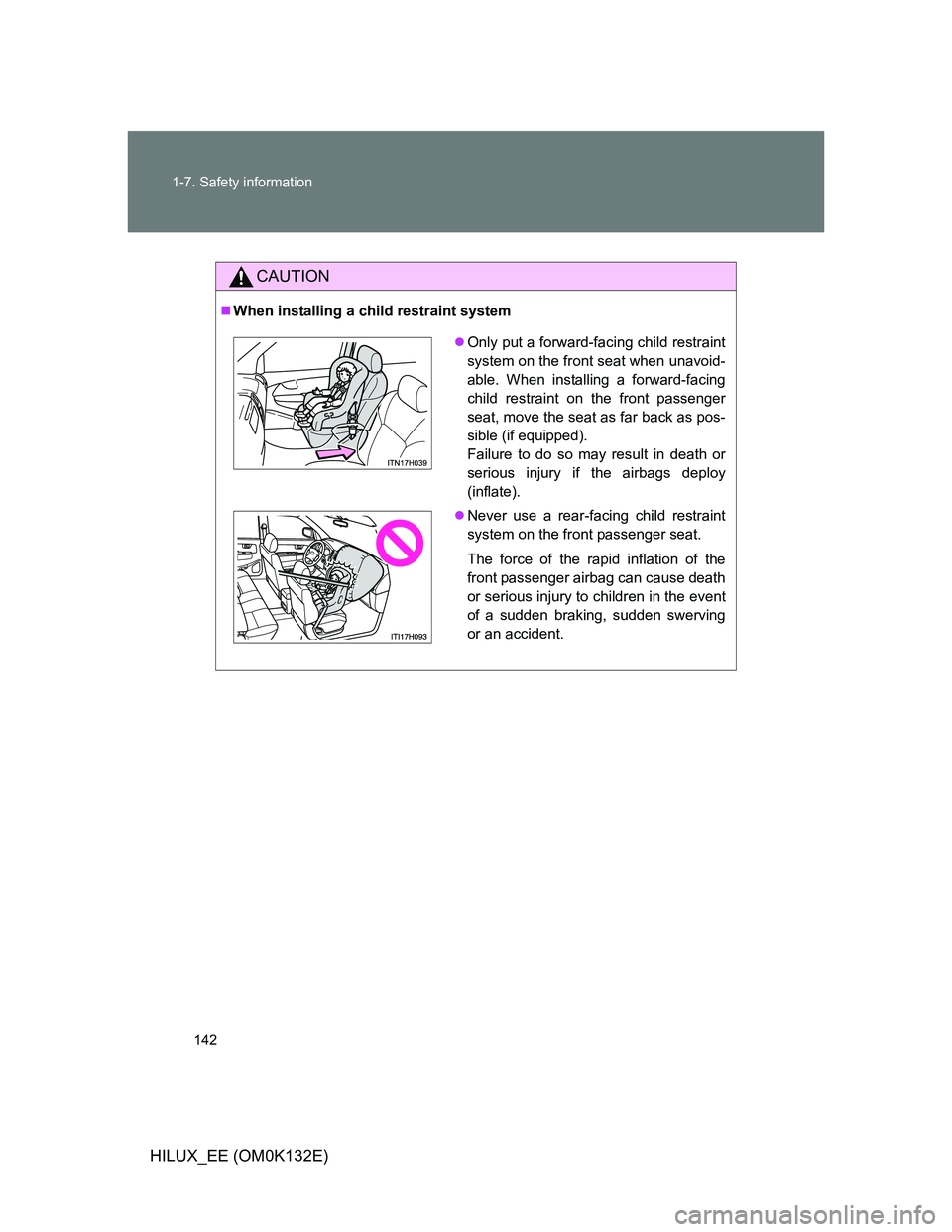
142 1-7. Safety information
HILUX_EE (OM0K132E)
CAUTION
When installing a child restraint system
Only put a forward-facing child restraint
system on the front seat when unavoid-
able. When installing a forward-facing
child restraint on the front passenger
seat, move the seat as far back as pos-
sible (if equipped).
Failure to do so may result in death or
serious injury if the airbags deploy
(inflate).
Never use a rear-facing child restraint
system on the front passenger seat.
The force of the rapid inflation of the
front passenger airbag can cause death
or serious injury to children in the event
of a sudden braking, sudden swerving
or an accident.
Page 143 of 636
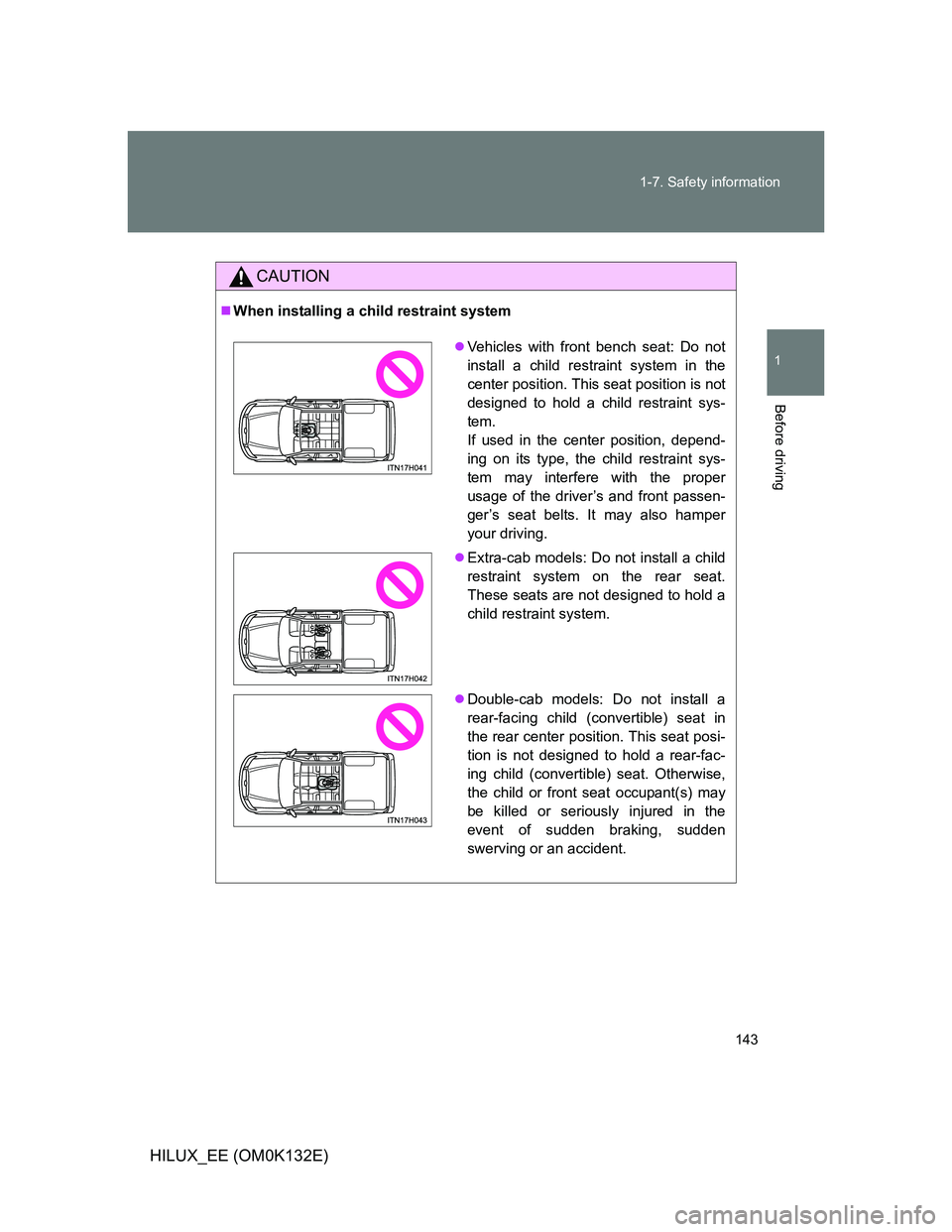
143 1-7. Safety information
1
Before driving
HILUX_EE (OM0K132E)
CAUTION
When installing a child restraint system
Vehicles with front bench seat: Do not
install a child restraint system in the
center position. This seat position is not
designed to hold a child restraint sys-
tem.
If used in the center position, depend-
ing on its type, the child restraint sys-
tem may interfere with the proper
usage of the driver’s and front passen-
ger’s seat belts. It may also hamper
your driving.
Extra-cab models: Do not install a child
restraint system on the rear seat.
These seats are not designed to hold a
child restraint system.
Double-cab models: Do not install a
rear-facing child (convertible) seat in
the rear center position. This seat posi-
tion is not designed to hold a rear-fac-
ing child (convertible) seat. Otherwise,
the child or front seat occupant(s) may
be killed or seriously injured in the
event of sudden braking, sudden
swerving or an accident.
Page 144 of 636

144 1-7. Safety information
HILUX_EE (OM0K132E)
CAUTION
When installing a child restraint system
If child restraint system regulations exist in the country where you reside,
please contact any authorized Toyota dealer or repairer, or another duly
qualified and equipped professional for the child restraint system installa-
tion.
When a junior seat is installed, always ensure that the shoulder belt is
positioned across the center of the child’s shoulder. The belt should be
kept away from the child’s neck, but not so that it could fall off the child’s
shoulder. Failing to do so may result in death or serious injury in the event
of a sudden braking, sudden swerving or an accident.
Ensure that the belt and plate are securely locked and the seat belt is not
twisted.
Push and pull the child restraint system from side to side and forward to be
sure it is secure.
After securing a child restraint system, never adjust the seat.
Follow all installation instructions provided by the child restraint system
manufacturer.
Page 145 of 636
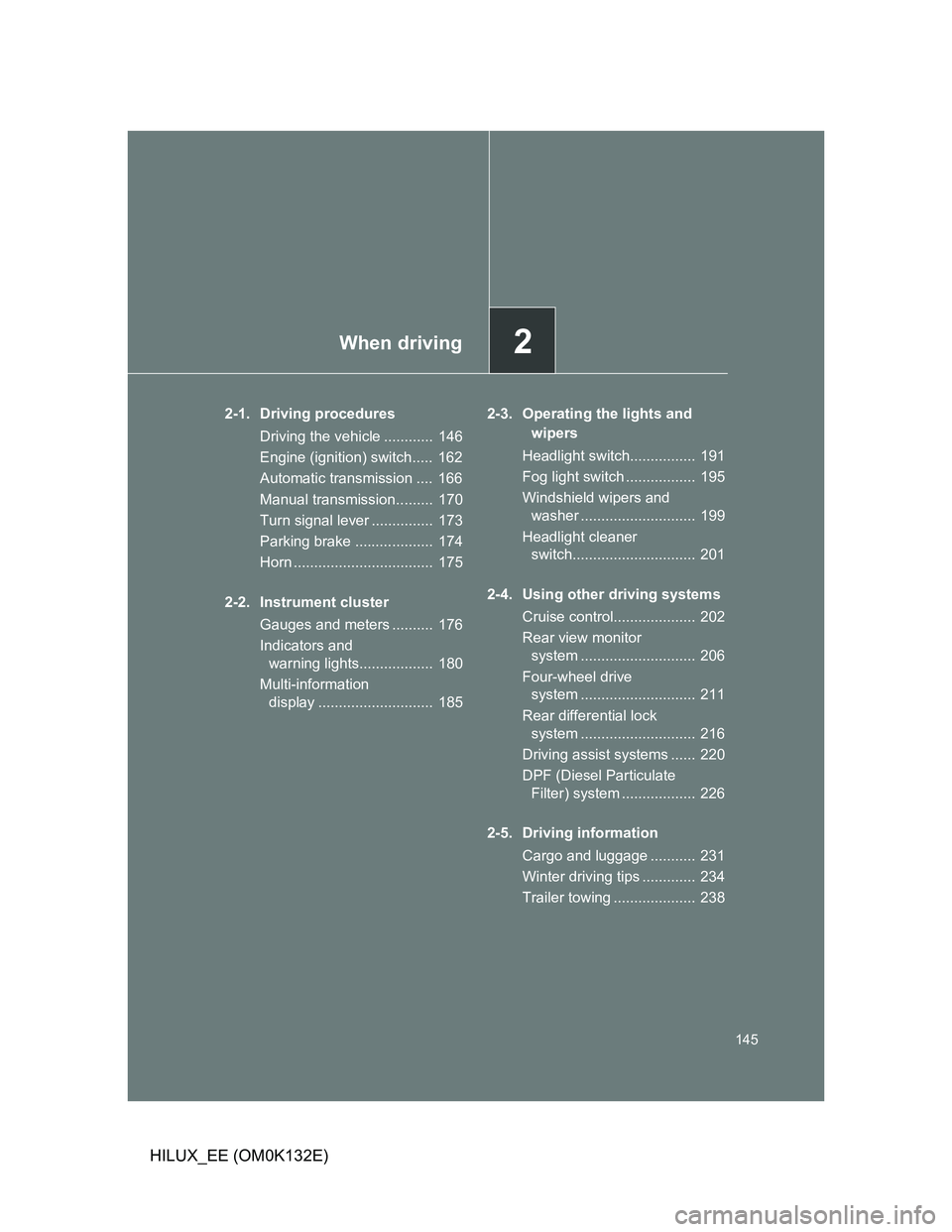
2When driving
145
HILUX_EE (OM0K132E)
2-1. Driving procedures
Driving the vehicle ............ 146
Engine (ignition) switch..... 162
Automatic transmission .... 166
Manual transmission......... 170
Turn signal lever ............... 173
Parking brake ................... 174
Horn .................................. 175
2-2. Instrument cluster
Gauges and meters .......... 176
Indicators and
warning lights.................. 180
Multi-information
display ............................ 1852-3. Operating the lights and
wipers
Headlight switch................ 191
Fog light switch ................. 195
Windshield wipers and
washer ............................ 199
Headlight cleaner
switch.............................. 201
2-4. Using other driving systems
Cruise control.................... 202
Rear view monitor
system ............................ 206
Four-wheel drive
system ............................ 211
Rear differential lock
system ............................ 216
Driving assist systems ...... 220
DPF (Diesel Particulate
Filter) system .................. 226
2-5. Driving information
Cargo and luggage ........... 231
Winter driving tips ............. 234
Trailer towing .................... 238
Page 146 of 636
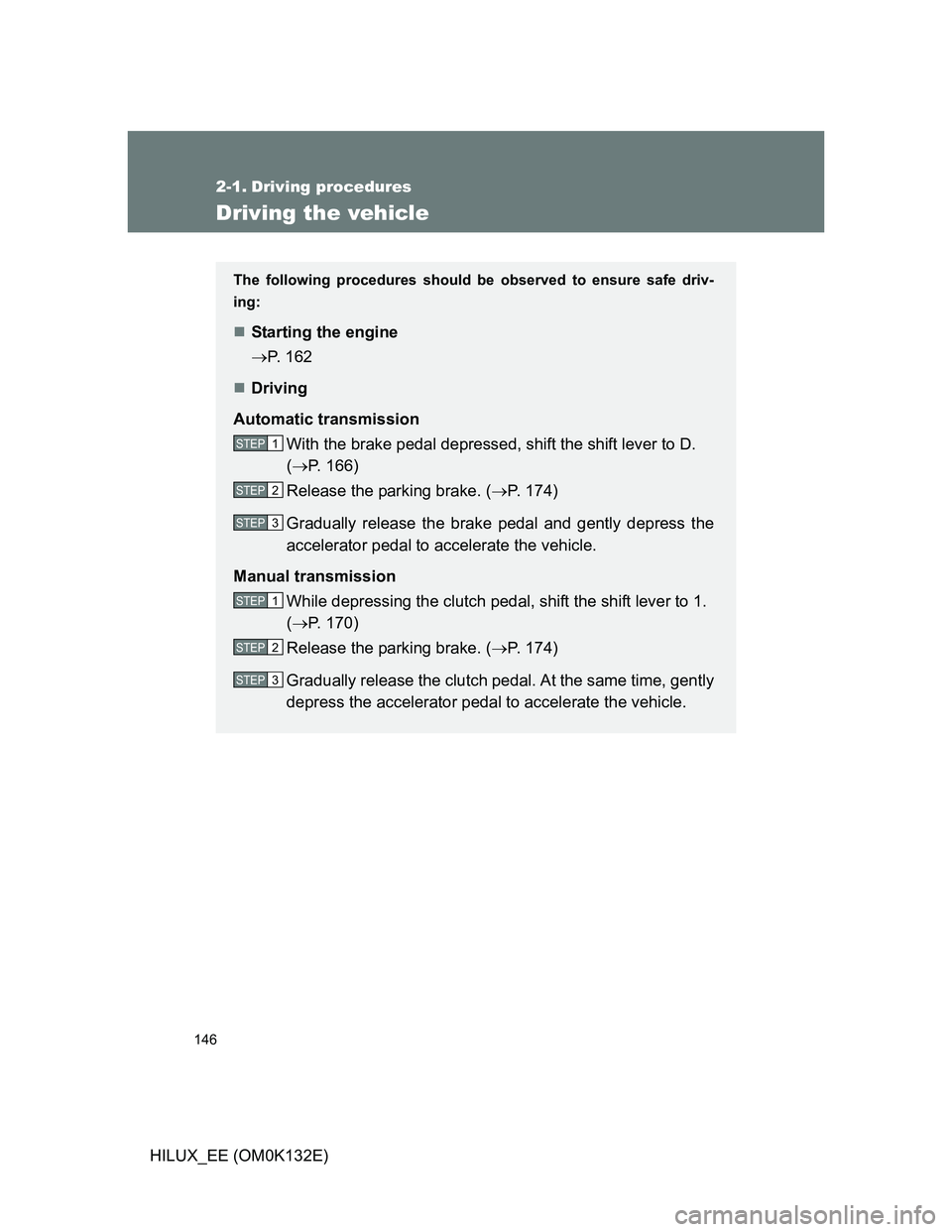
146
HILUX_EE (OM0K132E)
2-1. Driving procedures
Driving the vehicle
The following procedures should be observed to ensure safe driv-
ing:
Starting the engine
P. 162
Driving
Automatic transmission
With the brake pedal depressed, shift the shift lever to D.
(P. 166)
Release the parking brake. (P. 174)
Gradually release the brake pedal and gently depress the
accelerator pedal to accelerate the vehicle.
Manual transmission
While depressing the clutch pedal, shift the shift lever to 1.
(P. 170)
Release the parking brake. (P. 174)
Gradually release the clutch pedal. At the same time, gently
depress the accelerator pedal to accelerate the vehicle.
STEP1
STEP2
STEP3
STEP1
STEP2
STEP3
Page 147 of 636
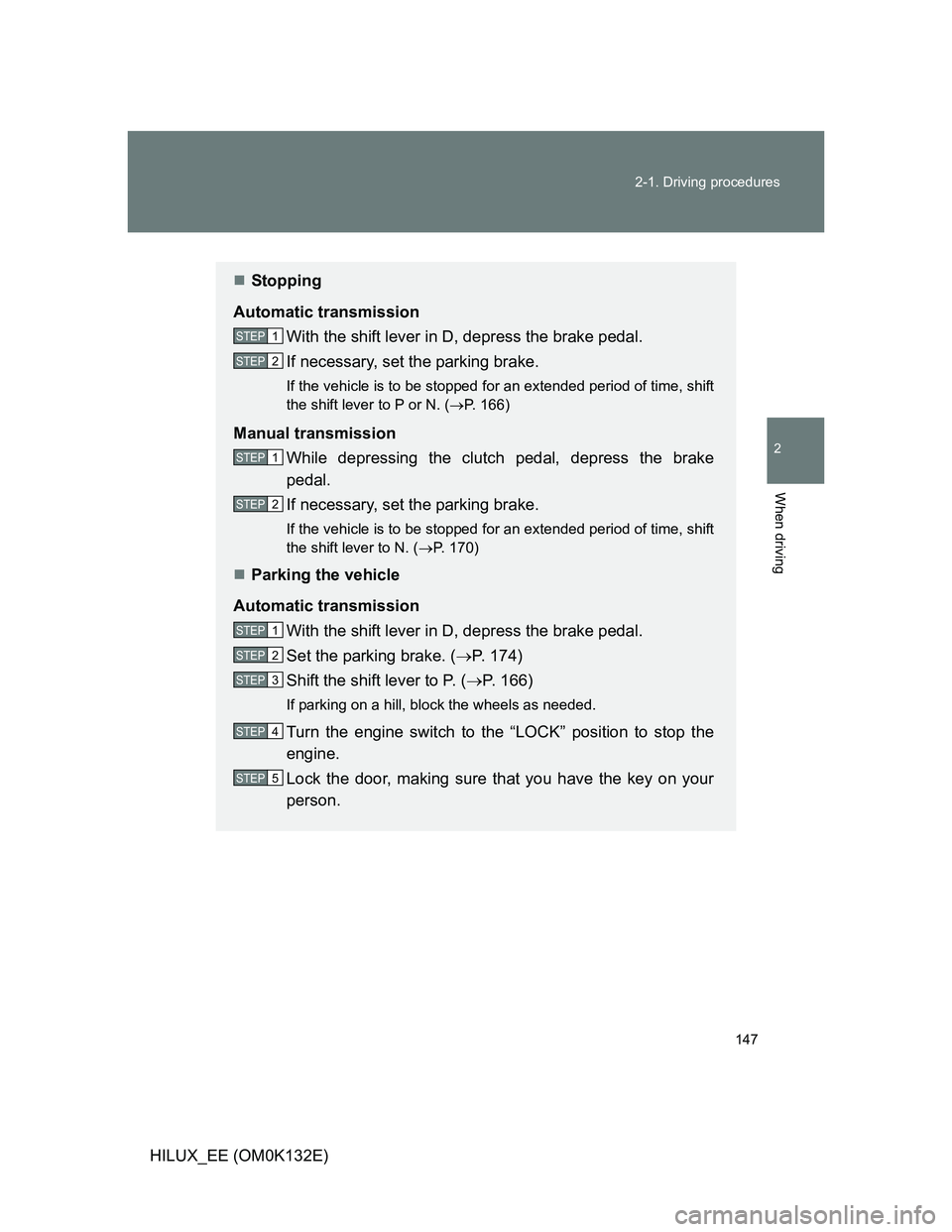
147 2-1. Driving procedures
2
When driving
HILUX_EE (OM0K132E)
Stopping
Automatic transmission
With the shift lever in D, depress the brake pedal.
If necessary, set the parking brake.
If the vehicle is to be stopped for an extended period of time, shift
the shift lever to P or N. (P. 166)
Manual transmission
While depressing the clutch pedal, depress the brake
pedal.
If necessary, set the parking brake.
If the vehicle is to be stopped for an extended period of time, shift
the shift lever to N. (P. 170)
Parking the vehicle
Automatic transmission
With the shift lever in D, depress the brake pedal.
Set the parking brake. (P. 174)
Shift the shift lever to P. (P. 166)
If parking on a hill, block the wheels as needed.
Turn the engine switch to the “LOCK” position to stop the
engine.
Lock the door, making sure that you have the key on your
person.
STEP1
STEP2
STEP1
STEP2
STEP1
STEP2
STEP3
STEP4
STEP5
Page 148 of 636
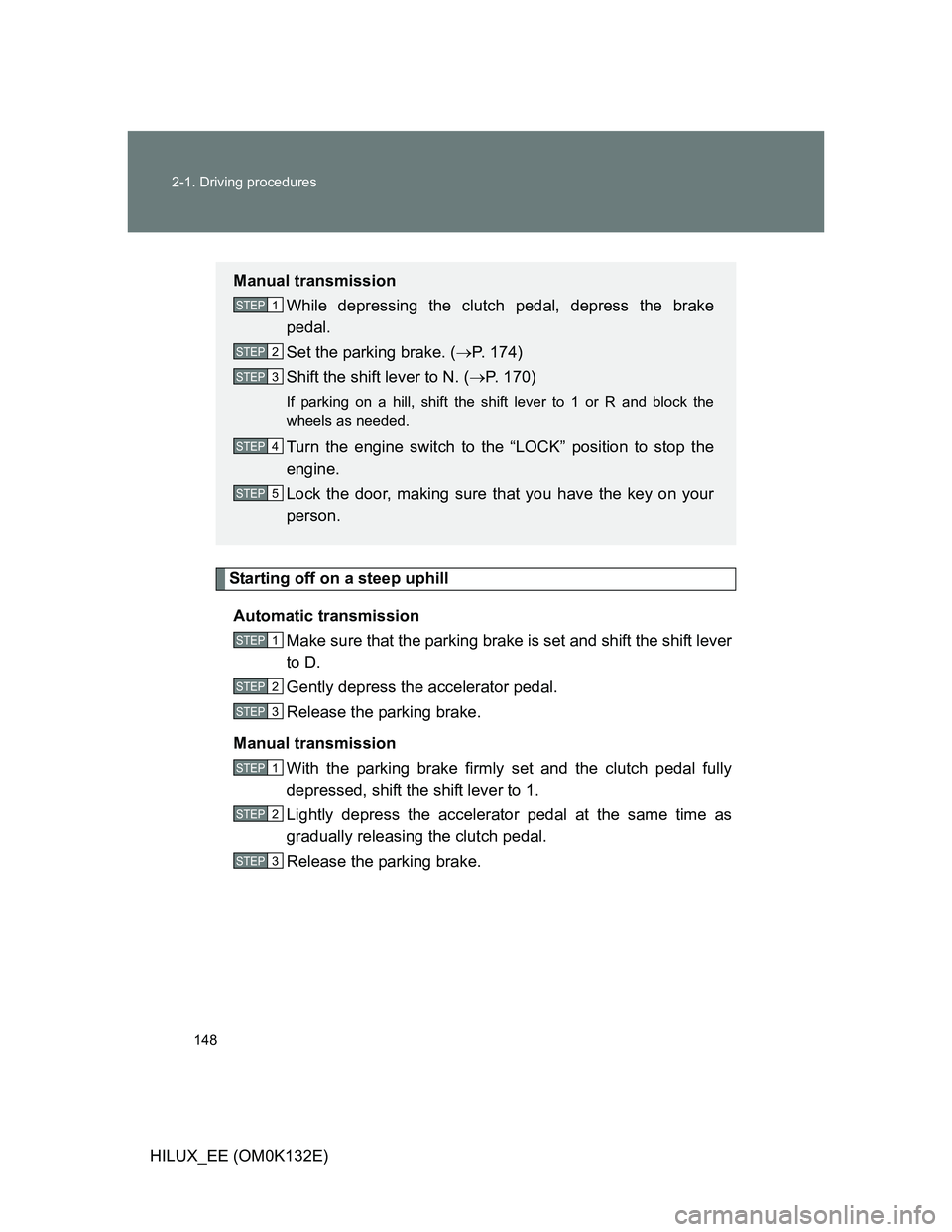
148 2-1. Driving procedures
HILUX_EE (OM0K132E)
Starting off on a steep uphill
Automatic transmission
Make sure that the parking brake is set and shift the shift lever
to D.
Gently depress the accelerator pedal.
Release the parking brake.
Manual transmission
With the parking brake firmly set and the clutch pedal fully
depressed, shift the shift lever to 1.
Lightly depress the accelerator pedal at the same time as
gradually releasing the clutch pedal.
Release the parking brake.
Manual transmission
While depressing the clutch pedal, depress the brake
pedal.
Set the parking brake. (P. 174)
Shift the shift lever to N. (P. 170)
If parking on a hill, shift the shift lever to 1 or R and block the
wheels as needed.
Turn the engine switch to the “LOCK” position to stop the
engine.
Lock the door, making sure that you have the key on your
person.
STEP1
STEP2
STEP3
STEP4
STEP5
STEP1
STEP2
STEP3
STEP1
STEP2
STEP3
Page 149 of 636
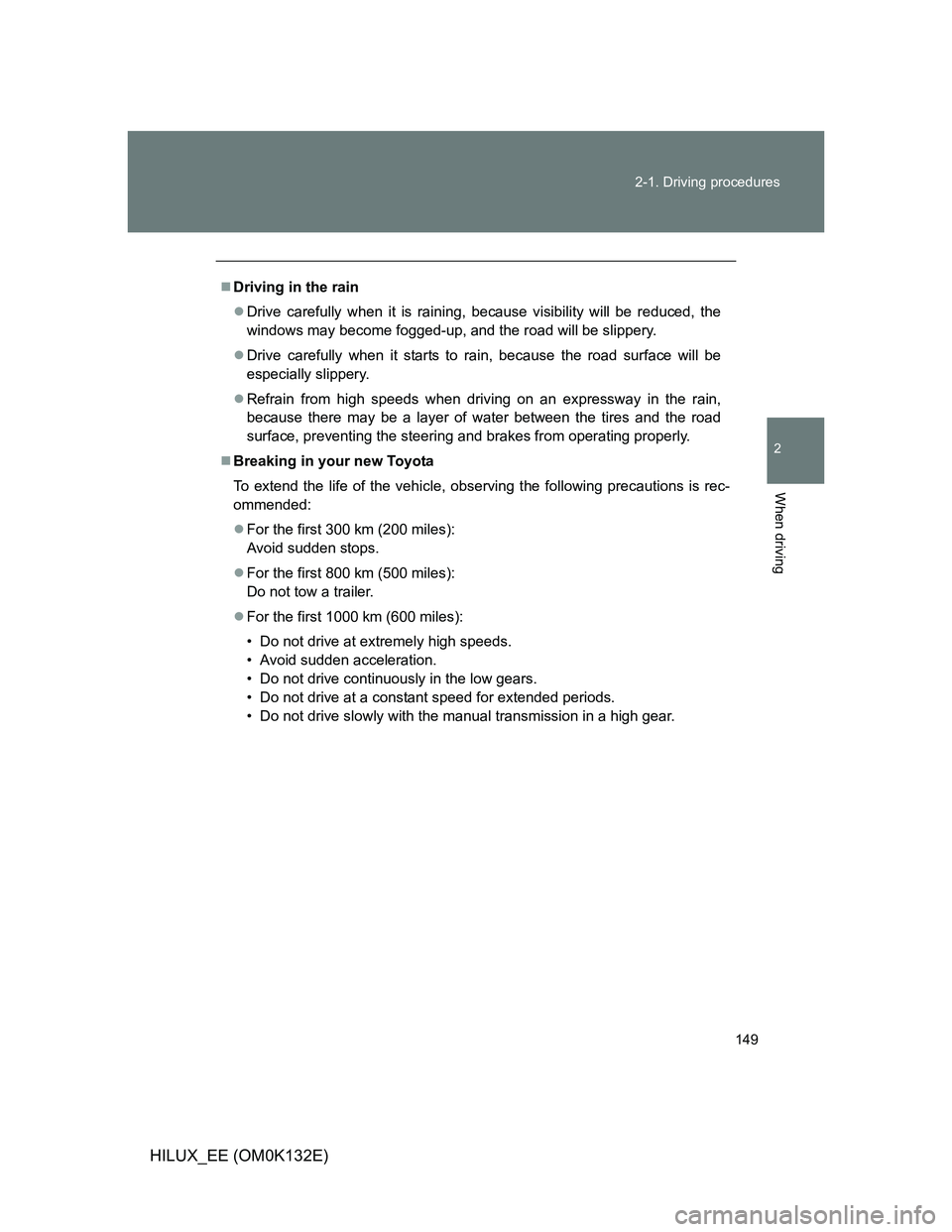
149 2-1. Driving procedures
2
When driving
HILUX_EE (OM0K132E)
Driving in the rain
Drive carefully when it is raining, because visibility will be reduced, the
windows may become fogged-up, and the road will be slippery.
Drive carefully when it starts to rain, because the road surface will be
especially slippery.
Refrain from high speeds when driving on an expressway in the rain,
because there may be a layer of water between the tires and the road
surface, preventing the steering and brakes from operating properly.
Breaking in your new Toyota
To extend the life of the vehicle, observing the following precautions is rec-
ommended:
For the first 300 km (200 miles):
Avoid sudden stops.
For the first 800 km (500 miles):
Do not tow a trailer.
For the first 1000 km (600 miles):
• Do not drive at extremely high speeds.
• Avoid sudden acceleration.
• Do not drive continuously in the low gears.
• Do not drive at a constant speed for extended periods.
• Do not drive slowly with the manual transmission in a high gear.
Page 150 of 636
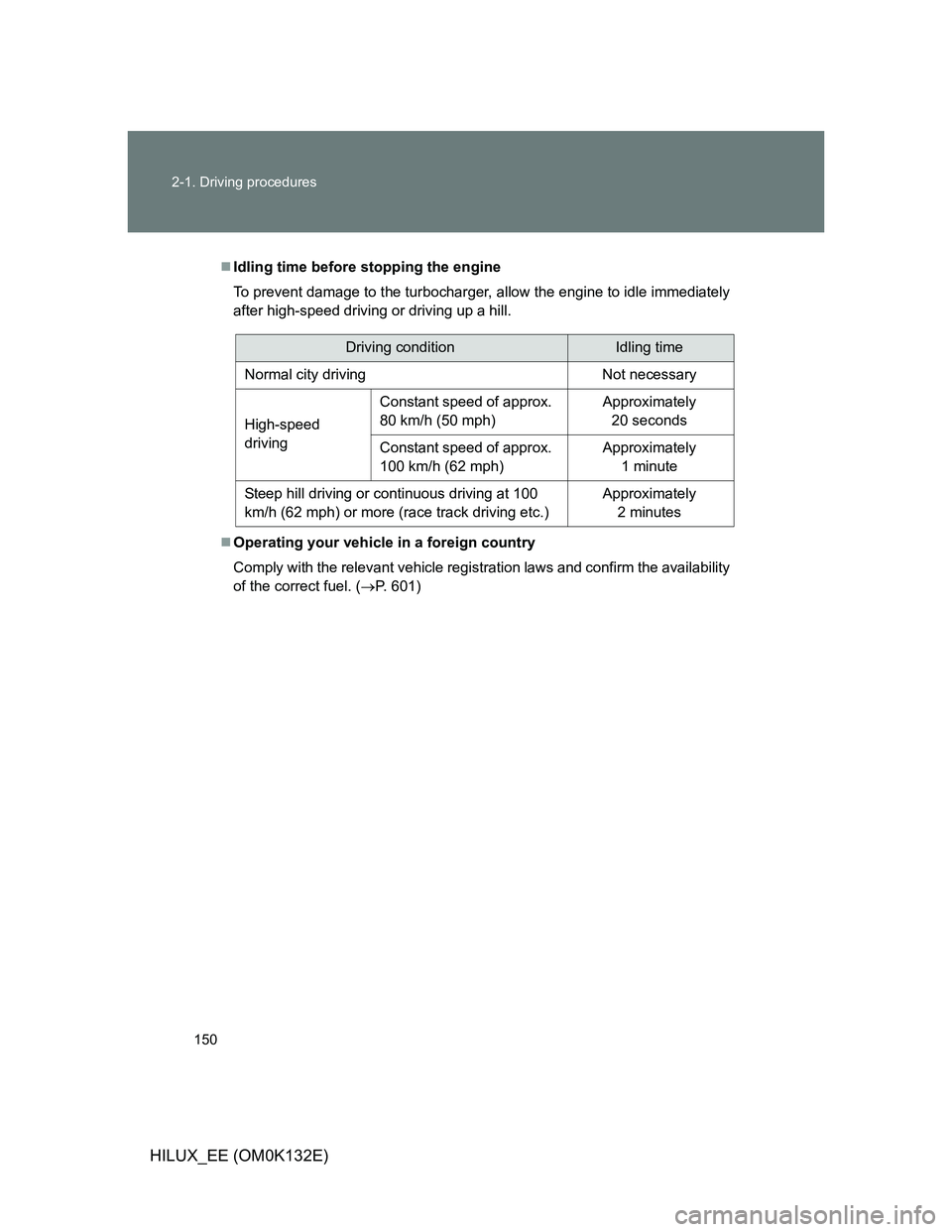
150 2-1. Driving procedures
HILUX_EE (OM0K132E)
Idling time before stopping the engine
To prevent damage to the turbocharger, allow the engine to idle immediately
after high-speed driving or driving up a hill.
Operating your vehicle in a foreign country
Comply with the relevant vehicle registration laws and confirm the availability
of the correct fuel. (P. 601)
Driving conditionIdling time
Normal city driving Not necessary
High-speed
drivingConstant speed of approx.
80 km/h (50 mph)Approximately
20 seconds
Constant speed of approx.
100 km/h (62 mph)Approximately
1 minute
Steep hill driving or continuous driving at 100
km/h (62 mph) or more (race track driving etc.)Approximately
2 minutes